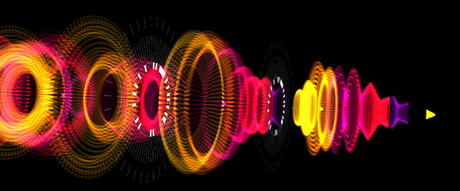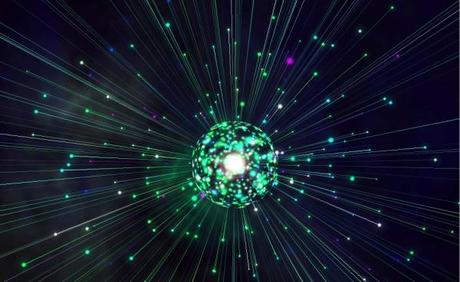
Recently, I was given the opportunity to review some SoundSpectrum music visualizers. You might know SoundSpectrum as the company that made G-Force, the visualizer that Apple licenses as the “Classic Visualizer” for iTunes. I was impressed to find out that they’ve also been licensed by Microsoft, Yahoo, Aerosmith, Journey, and have a subscriber base of 4.5 million users. They certainly have a lot of clout, but could they live up to it?
SoundSpectrum’s visualizers come in four different varieties: WhiteCap, Aeon, SoftSkies, and G-Force. Each have their own distinct tones and moods. WhiteCap is a simple, but fun, wireframe visual landscape that can run on any computer. Aeon is a more intensive program that creates 3-D scenes right before your very eyes. SoftSkies is a calmer, sedate experience that simulates clouds moving across the sky. G-Force is the flagship visualizer, which combines the best of all four.
When I started up WhiteCap, I immediately notice the cool “retro” feel to all the visualizers. It was like watching all the cool parts of Tron, or hacking into a mianfram from the 1980’s. Gridlines began to form familiar patterns from Akira and Evangelion, and then bend and twist away into new shapes. Colors, from monochrome green to electrifying rainbows, rippled across the visuals and backgrounds. I was running this on a computer that was 3 or 4 (or more) years old, and it didn’t have any trouble keeping up with my dance music.

Next up was Aeon. If Whitecap was a Shelby Cobra, then Aeon is the Millenium Falcon. It is futuristic, well-animated, and riveting to watch. The three-dimensional scenes that play out in Aeon are second to none. It was so cool to watch stars explode, plants grow, and monolithic structures assemble and implode to the beat of my music. It even came with a beat detector tool, and other audio tools, to help me analyze my music! Again, SoundSpectrum outdid itself with the color and lighting in this program. I did need to use my newer computer to play with Aeon effectively, but anyone with a computer older computer should be able to lower their graphical settings slightly and have things run smoothly.
SoftSkies is a whole different animal. So far, all the visualizers have made me want to get up and party, but SoftSkies was so relaxing. This visualizer creates patterns out of a simulated sky that change shape and direction to the music being played. I lost myself in creating the perfect sky, choosing the time of day, the color, the weather, and the direction of the wind. Then I went through the different cloud formations, and selected a landscape that I’d like to see my sky over. I decided that I wanted to see a stormy green sky, with animal-shaped clouds, over the Utah desert. Then, I just sat back and watched the clouds drift away for over an hour. This was a delightful program, and ran perfectly on my old computer.
G-Force was nothing short of amazing. Wave patterns and geometric shapes dance around each other in a dazzling display, while murky vapors trail behind and create a brilliant flowpattern in their wake. The backgrounds subtly support the scene, while creating a wonderful wallpaper of visual magic. G-Force takes what I loved most about each visualizer, and creates a beautiful symbiosis between them. And somehow, the visualizer seems to know when to slow down and simplify the show, before it pulls out all the stops and creates a fantastic digital fireworks display. And there are so many options to choose from! G-Force has a strong community of users, who are constantly creating and providing new content for the program. There are literally millions of combinations and unique scenes.
And speaking of customization, Sound Spectrum has created a scripting interface for every one of their programs. If you like a scene, you can call recall it instantly with a keyboard key or by using a GUI button. If you want to get really in-depth, you can create Python scripts and create long sequences of visuals for your concert or performance. Personally, I have no real programming experience, but Python is a simple enough programming language to use that I was able to start making my own scripts quickly.
In short, SoundSpectrum has created some amazing personal and commercial music visualizers. They completely live up to the hype. And you don’t have to take my word for it: there are free trial versions of each title available on their website (www.soundspectrum.com). And from my interactions with their support and designer staff, they seem like a company worth supporting. Check them out!
SoundSpectrum is the leading provider of commercial-grade, real-time music/audio visualization software, offering the widely-known software products G-Force, SoftSkies, Aeon, and WhiteCap.
G-Force has been licensed by Apple for use in iTunes as its built-in classic visualizer, and SoundSpectrumsoftware has also been licensed by Microsoft and Yahoo (Musicmatch). SoundSpectrum markets its software directly to consumers via download, and maintains an up-to-date opt-in subscriber base of over 4.5 million users worldwide.
SoundSpectrum also markets to professional musicians and production companies. Its software and services have been licensed by artists as diverse as Aerosmith, Herbie Hancock, Journey, George Michael, Soulja Boy, and the Southern Arizona Symphony Orchestra.
Since SoundSpectrum’s founding in 2000, its visualizers have been profiled and reviewed in many publications and web sites, including Wired Magazine, and various software titles have been downloaded over 20 million times worldwide. Its products continue to set the standard for real-time, procedurally-generated audio visualization.
SoundSpectrum believes that the time has come to bring its already-successful visualizers to the Spotify platform that offers our users unprecedented social networking opportunity and a vast music library.
G-Force is a music visualization plug-in for media players that also visualizes auxiliary or “line-in” audio. G-Force features fast anti-aliased effects, millions of possible visual combinations, savable and scriptable effects, and unparalleled expandability. G-Force is designed to entertain you on its own, but there are many ways it can be customized and extended. G-Force has been described as “mind-blowing” and “legendary” in the press and by its many fans.
We help visuals fit a musical style or genre by letting the users make their own choices. Each of our visualizers has many visual elements that make up what is on the user’s screen. By letting the user select which ones they like the best, they’re able to create the visualizer that they want to see. If a WaveShape looks better with hard rock than smooth jazz, that is entirely up to the user. If the user feels so inclinced, they can create their own content for our visualizer as well.
It’s definitely a tough choice to decide how much we let our elements be affected by audio. You want to make each scene unique, but you also want it to look cohesive. We spend a lot of time writing, testing, and re-writing our scenes so that they look good. Then, again, we let our users do the fine-tuning. They can edit any visual element that is used in our visualizers, as well as the general reactivity of each element.
Each visuzlier h as a “style” to it. G-Force is blah, WhiteCap is blah, and Aeon is blah. Right now we’re working on FLux, which is blah. And Darkroom which allows users to create and share videos of their visuals. We want each visualizer to be accessible, but infinitely customizable. Like a good game, they should be easy to learn but impossible to master. They should be uncluttered but beautiful. And as always, we want to allow the maximum input from our users.
